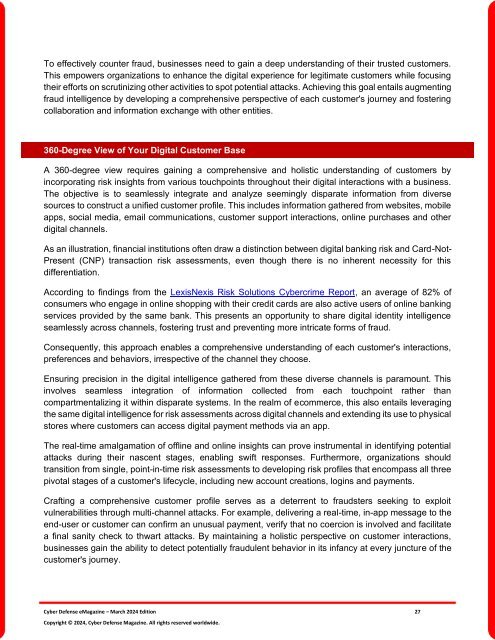The Cyber Defense eMagazine March Edition for 2024
Cyber Defense eMagazine March Edition for 2024 #CDM #CYBERDEFENSEMAG @CyberDefenseMag by @Miliefsky a world-renowned cyber security expert and the Publisher of Cyber Defense Magazine as part of the Cyber Defense Media Group as well as Yan Ross, Editor-in-Chief and many more writers, partners and supporters who make this an awesome publication! 225 page March Edition fully packed with some of our best content. Thank you all and to our readers! OSINT ROCKS! #CDM #CDMG #OSINT #CYBERSECURITY #INFOSEC #BEST #PRACTICES #TIPS #TECHNIQUES
Cyber Defense eMagazine March Edition for 2024 #CDM #CYBERDEFENSEMAG @CyberDefenseMag by @Miliefsky a world-renowned cyber security expert and the Publisher of Cyber Defense Magazine as part of the Cyber Defense Media Group as well as Yan Ross, Editor-in-Chief and many more writers, partners and supporters who make this an awesome publication! 225 page March Edition fully packed with some of our best content. Thank you all and to our readers! OSINT ROCKS! #CDM #CDMG #OSINT #CYBERSECURITY #INFOSEC #BEST #PRACTICES #TIPS #TECHNIQUES
You also want an ePaper? Increase the reach of your titles
YUMPU automatically turns print PDFs into web optimized ePapers that Google loves.
To effectively counter fraud, businesses need to gain a deep understanding of their trusted customers.<br />
This empowers organizations to enhance the digital experience <strong>for</strong> legitimate customers while focusing<br />
their ef<strong>for</strong>ts on scrutinizing other activities to spot potential attacks. Achieving this goal entails augmenting<br />
fraud intelligence by developing a comprehensive perspective of each customer's journey and fostering<br />
collaboration and in<strong>for</strong>mation exchange with other entities.<br />
360-Degree View of Your Digital Customer Base<br />
A 360-degree view requires gaining a comprehensive and holistic understanding of customers by<br />
incorporating risk insights from various touchpoints throughout their digital interactions with a business.<br />
<strong>The</strong> objective is to seamlessly integrate and analyze seemingly disparate in<strong>for</strong>mation from diverse<br />
sources to construct a unified customer profile. This includes in<strong>for</strong>mation gathered from websites, mobile<br />
apps, social media, email communications, customer support interactions, online purchases and other<br />
digital channels.<br />
As an illustration, financial institutions often draw a distinction between digital banking risk and Card-Not-<br />
Present (CNP) transaction risk assessments, even though there is no inherent necessity <strong>for</strong> this<br />
differentiation.<br />
According to findings from the LexisNexis Risk Solutions <strong>Cyber</strong>crime Report, an average of 82% of<br />
consumers who engage in online shopping with their credit cards are also active users of online banking<br />
services provided by the same bank. This presents an opportunity to share digital identity intelligence<br />
seamlessly across channels, fostering trust and preventing more intricate <strong>for</strong>ms of fraud.<br />
Consequently, this approach enables a comprehensive understanding of each customer's interactions,<br />
preferences and behaviors, irrespective of the channel they choose.<br />
Ensuring precision in the digital intelligence gathered from these diverse channels is paramount. This<br />
involves seamless integration of in<strong>for</strong>mation collected from each touchpoint rather than<br />
compartmentalizing it within disparate systems. In the realm of ecommerce, this also entails leveraging<br />
the same digital intelligence <strong>for</strong> risk assessments across digital channels and extending its use to physical<br />
stores where customers can access digital payment methods via an app.<br />
<strong>The</strong> real-time amalgamation of offline and online insights can prove instrumental in identifying potential<br />
attacks during their nascent stages, enabling swift responses. Furthermore, organizations should<br />
transition from single, point-in-time risk assessments to developing risk profiles that encompass all three<br />
pivotal stages of a customer's lifecycle, including new account creations, logins and payments.<br />
Crafting a comprehensive customer profile serves as a deterrent to fraudsters seeking to exploit<br />
vulnerabilities through multi-channel attacks. For example, delivering a real-time, in-app message to the<br />
end-user or customer can confirm an unusual payment, verify that no coercion is involved and facilitate<br />
a final sanity check to thwart attacks. By maintaining a holistic perspective on customer interactions,<br />
businesses gain the ability to detect potentially fraudulent behavior in its infancy at every juncture of the<br />
customer's journey.<br />
<strong>Cyber</strong> <strong>Defense</strong> <strong>eMagazine</strong> – <strong>March</strong> <strong>2024</strong> <strong>Edition</strong> 27<br />
Copyright © <strong>2024</strong>, <strong>Cyber</strong> <strong>Defense</strong> Magazine. All rights reserved worldwide.

















